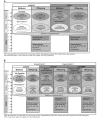Effects of Embryo Transfer on Emotional Behaviors in C57BL/6 Mice
- PMID: 27657704
- PMCID: PMC5029820
Effects of Embryo Transfer on Emotional Behaviors in C57BL/6 Mice
Abstract
Microbiologic standardization plays a key role in the management of animal facilities because contamination of stock could affect the health status and wellbeing of animals and thereby induce artifacts in biomedical research. One common method to avoid the dissemination of pathogens is embryo transfer (ET). Although disturbances in the perinatal environment may cause long-lasting effects on the behavior and physiology of mouse offspring, the influences of ET during this sensitive phase have not yet been addressed. Our study investigated the effects of various components of ET (anesthesia, surgery, recipient strain) on the behavior of dams (exploration, nest-building) and offspring (nest-building, exploration, anxiety, and social and depressive-like behaviors). For ET, the donor strain C57BL/6N and a standard protocol were used. Whereas treatment with anesthesia-analgesia did not affect maternal behavior, female offspring demonstrated overall effects on weight gain and corticosterone levels. Compared with naturally delivered female offspring, dams obtained through ET demonstrated decreased exploration and nest-building. In addition, female ET-derived offspring had enhanced levels of anxiety and increased social interest. Furthermore, ET-derived dams obtained by using NMRI as the recipient strain showed increased exploratory behavior compared with that of dams obtained by using C57 mice as recipients. Compared with using C57 as recipients, both sexes of offspring transferred into NMRI recipients weighed more, and female mice showed a depressive-like phenotype. Our findings suggest that ET, now considered to be a routine procedure in animal husbandry, bears the risk of introducing artifacts.
Figures




Similar articles
-
Effects of rat odour and shelter on maternal behaviour in C57BL/6 dams and on fear and stress responses in their adult offspring.Physiol Behav. 2008 Jun 9;94(3):393-404. doi: 10.1016/j.physbeh.2008.02.006. Epub 2008 Feb 14. Physiol Behav. 2008. PMID: 18346766
-
The scent of stress: environmental challenge in the peripartum environment of mice affects emotional behaviours of the adult offspring in a sex-specific manner.Lab Anim. 2016 Jun;50(3):167-78. doi: 10.1177/0023677215603260. Epub 2015 Sep 25. Lab Anim. 2016. PMID: 26408077
-
Mice age - Does the age of the mother predict offspring behaviour?Physiol Behav. 2015 Aug 1;147:157-62. doi: 10.1016/j.physbeh.2015.04.041. Epub 2015 Apr 24. Physiol Behav. 2015. PMID: 25914174
-
Effects of foraging demand on maternal behaviour and adult offspring anxiety and stress response in C57BL/6 mice.Behav Brain Res. 2009 Jan 23;196(2):192-9. doi: 10.1016/j.bbr.2008.08.042. Epub 2008 Sep 4. Behav Brain Res. 2009. PMID: 18809439
-
Selection, evolution of behavior and animal models in behavioral neuroscience.Neurosci Biobehav Rev. 1999 Nov;23(7):957-69. doi: 10.1016/s0149-7634(99)00029-9. Neurosci Biobehav Rev. 1999. PMID: 10580310 Review.
Cited by
-
Colony aging affects the reproductive performance of Swiss Webster females used as recipients for embryo transfer.Anim Reprod. 2020 Nov 24;17(4):e20200524. doi: 10.1590/1984-3143-AR2020-0524. Anim Reprod. 2020. PMID: 33791029 Free PMC article.
References
-
- Bedford PD. 1955. Adverse cerebral effects of anaesthesia on old people. Lancet 269:259–263. - PubMed
-
- Burgdorf J, Panksepp J, Brudzynski SM, Beinfeld MC, Cromwell HC, Kroes RA, Moskal JR. 2009. The effects of selective breeding for differential rates of 50-kHz ultrasonic vocalizations on emotional behavior in rats. Dev Psychobiol 51:34–46. - PubMed
-
- Byrnes EM. 2005. Transgenerational consequences of adolescent morphine exposure in female rats: effects on anxiety-like behaviors and morphine sensitization in adult offspring. Psychopharmacology (Berl) 182:537.–. - PubMed
MeSH terms
Substances
LinkOut - more resources
Full Text Sources
